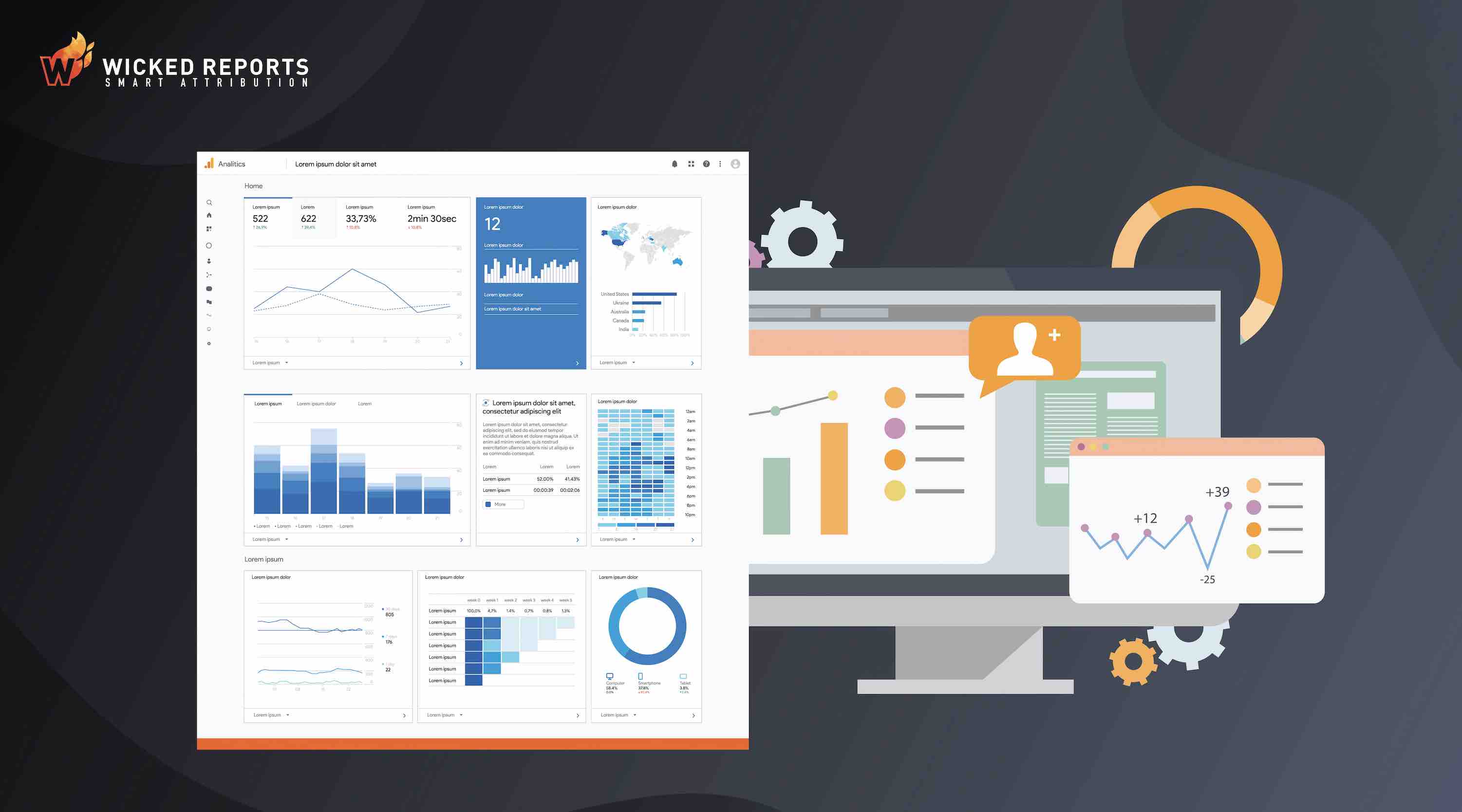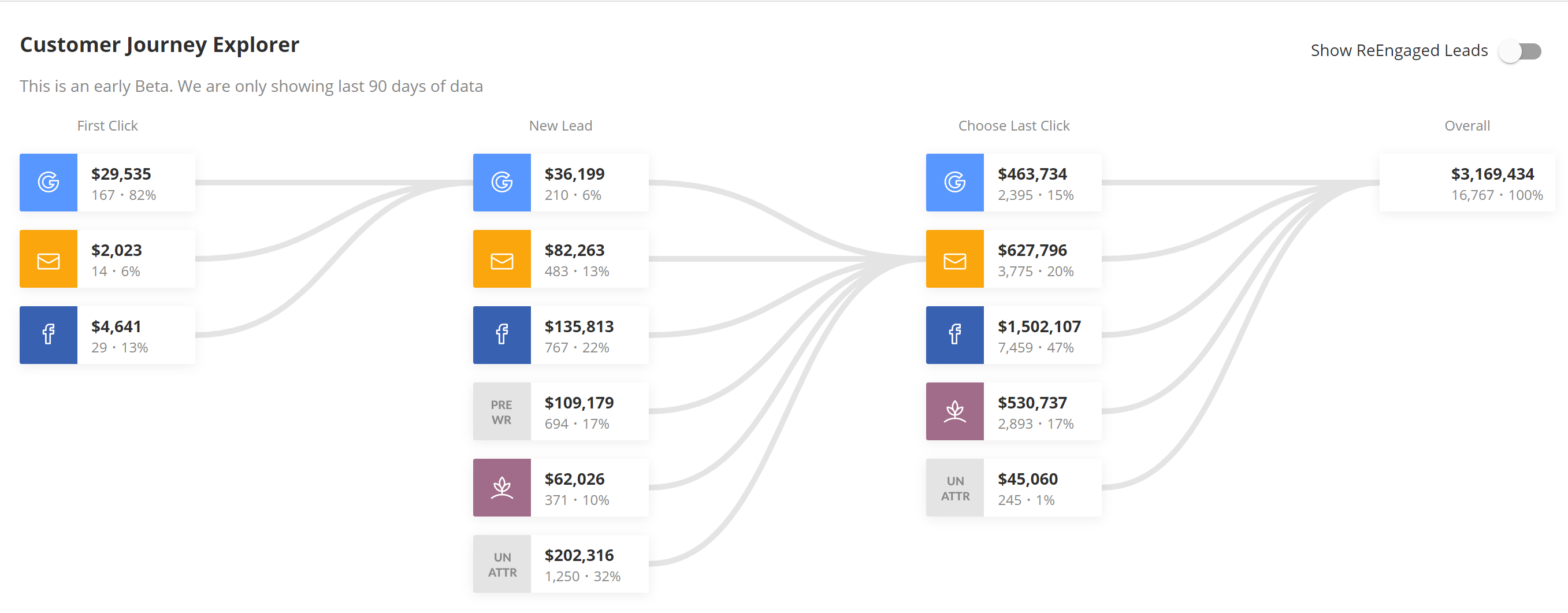Marketing attribution is the art of identifying those channels, campaigns, and individual ads that contributed to a single conversion.
Since 67% of consumers use more than one channel to complete a single purchase, it’s not as simple as tracking conversions on a single platform.
To get a complete grasp on the customer journey and use the data to improve your marketing campaigns, you need to implement complex attribution models.
In this article, we’ll cover what marketing attribution is, discuss the different attribution models, recommend tools you can use, and break down how your business can use attribution to improve your marketing results.
Are you frustrated by inaccurate lead or conversion attribution?
Learn how WickedReports can help.
What does attribution mean in marketing?
Attribution is the discipline that measures which campaigns, marketing channels, and strategies are contributing toward your business’ sales, leads, or other crucial conversions.
To put it simply, it’s how you find out which parts of your marketing efforts are driving results.
If you just run a single marketing campaign with one ad on a single platform (like your local newspaper), you will know where any new business comes from by default.
But with the rise of digital platforms and ever-increasing options for business owners, it’s no longer that simple. Most advertisers have tens, if not hundreds or thousands of different ads spread across multiple platforms.
And it's not just ads. Many businesses have multiple social media profiles, (even multiple websites), all driving prospective customers through complicated marketing and sales funnels.
To find out which ones are delivering the goods, you need to track and analyze the impact of different customer touchpoints.
What is a marketing attribution model?
Marketing attribution models are sets of rules that decide how you give credit for sales or conversions across ads, campaigns, and marketing channels.
Here are a few different attribution model types (we'll get more into this below):
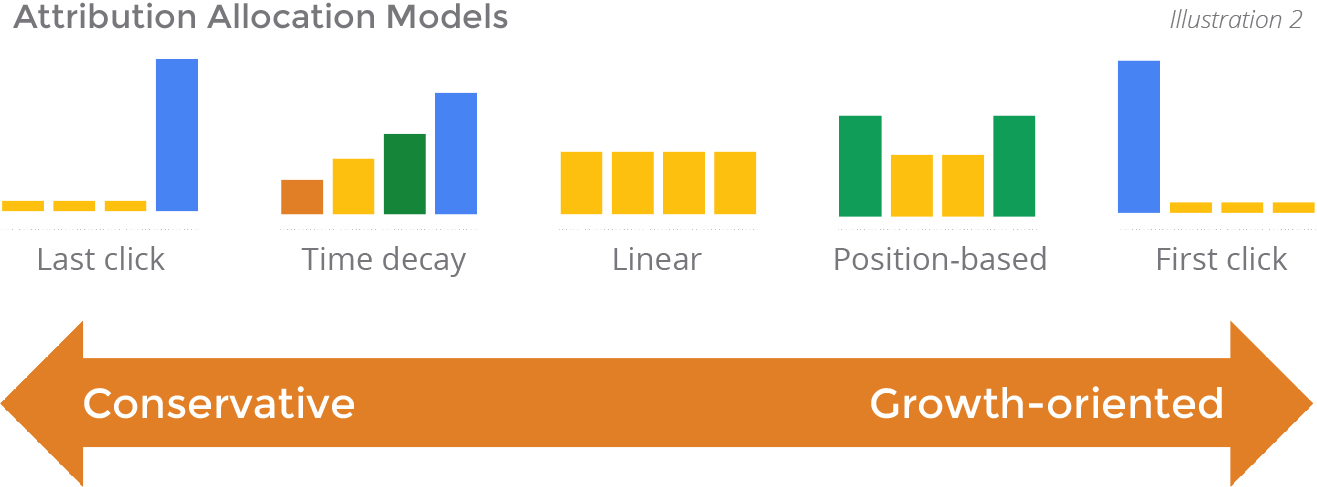
Different single-touch attribution and multi-touch models let you view a single conversion through a different, more accurate lens.
What's a touchpoint?
A touch or touchpoint is an interaction between a prospect or customer and your brand. It can happen on any channel and be part of any campaign or marketing effort.
It could be everything from a customer seeing a Google ad when searching for something relevant, to seeing your ad in a video, or a subscriber receiving a promotional email.
By focusing on touchpoints differently, it will highlight different ad groups, campaigns, and platforms.
You could identify how a display ad is essential in converting actively interested prospects by focusing on later events. At the same time, organic or paid search campaigns drive much of the top-of-funnel traffic.
Single-touch attribution models
A single-touch attribution model gives 100% of the credit to a single customer touchpoint, either their first or last.
Even if the customer interacted with your brand through on other occasions, that doesn’t get counted in the attribution. Only one campaign will get cleanly allotted 100% of the credit for the conversion.
While it may seem simplistic, by monitoring first and last touchpoint, you can get valuable insights into the customer journey, and it's a great place to start with marketing attribution.
Let's take a closer look at both single-touch attribution models...
Last-touch attribution
Last-touch is the most common attribution model for PPC, often referred to as last-click.
It gives 100% of the credit to the campaign, ad group, and ad that drives the last identifiable click before a conversion takes place.
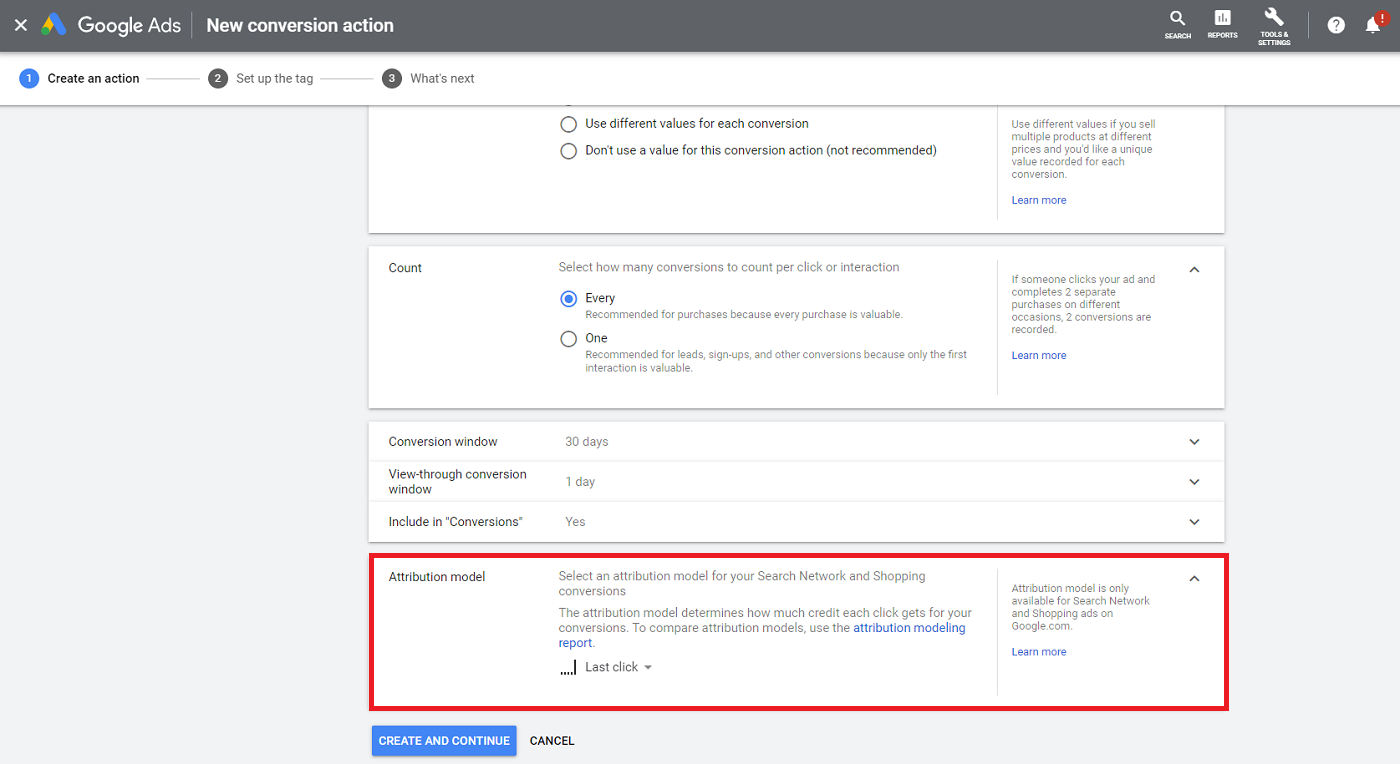
It’s the default model for any new Google Ads conversion action.
The model can be problematic, however, as it can give undue credit to remarketing and branded search campaigns.
These campaigns target an audience that is already familiar with your brand — someone that might even have made the purchasing decision independently from the last campaign.
If you look exclusively at last-touch, you will mostly see which campaigns are affecting the bottom of your marketing funnel.
First-touch attribution
With the first-touch attribution model, 100% of the credit for a conversion goes to the initial touchpoint, the very first ad click, organic search, or video view.

It’s a better model for analyzing which campaigns have a branding effect, and effectively get prospects into the top of your funnel.
Instead of remarketing and branded search, you will typically find organic and paid unbranded search, social media, as well as other top-of-funnel marketing efforts, represented better with this model.
But no single-touch model can tell the whole story of your customers’ journey. To do that, you need to track and assign value to multiple touchpoints.
Multi-touch attribution models
The two leading challenges that marketers relate to are getting a complete view of customers over multiple interactions and tracking marketing effectiveness:
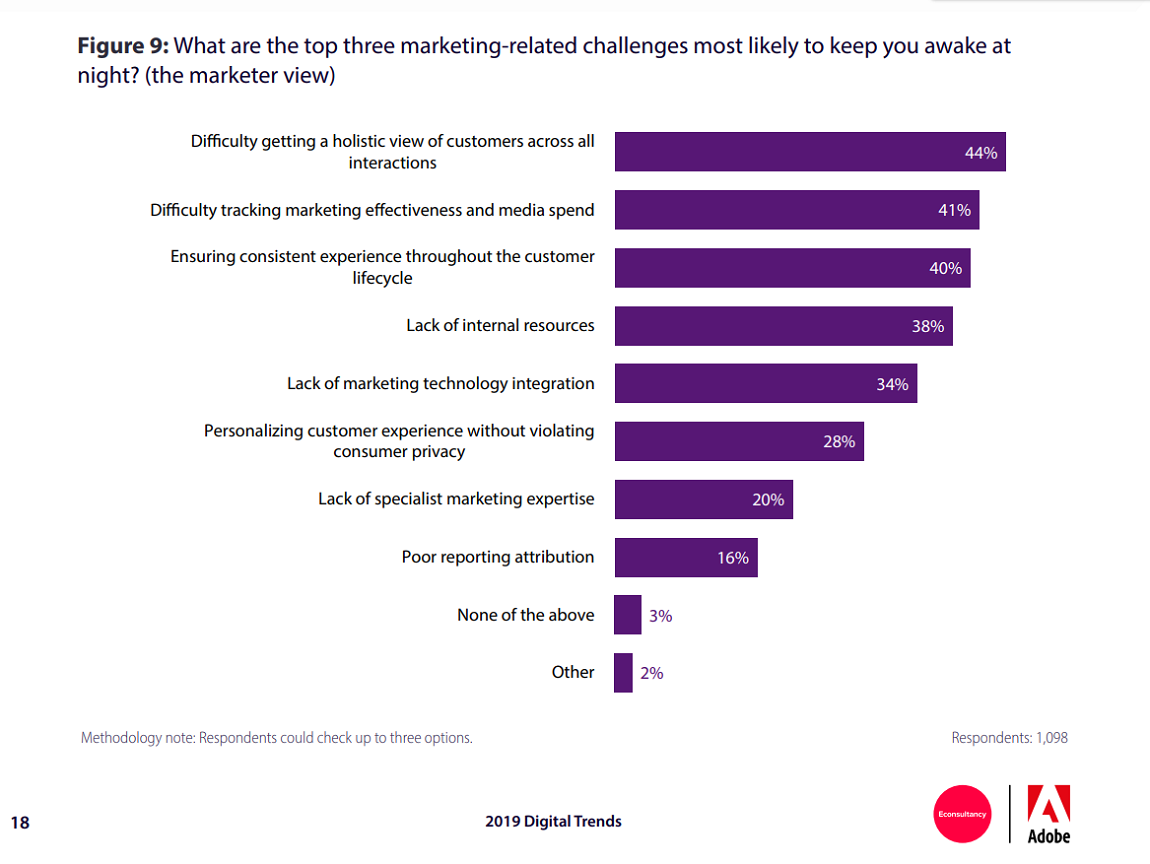
With a single-touch model, it’s not even possible to get close to a holistic view of your customers.
Multi-touch attribution models better cover the entire customer journey, track advertising efficiency across channels, and let you make smarter marketing decisions.
Instead of ignoring integral touch points in the middle, you can see every single customer touchpoint and how they fit into the bigger picture.
Let's take a look at different multi-touch attribution models....
Linear attribution
Linear attribution models spread the conversion credit out evenly across every ad, ad group, and campaign.
For example, if a customer saw and clicked on four different ads, over a few weeks, each ad would get credit with 0.25, a quarter of a conversion.
The linear model helps you identify all the platforms, campaigns, and ads that contribute. Still, because the value is divided evenly with no consideration for timing, it doesn’t highlight which are the most important.
It’s most useful when you don’t have clearly defined middle-of-funnel events that show how prospects move down a funnel.
Time decay attribution
Time decay attribution divides the conversion credit among campaigns but gives more value to recent interactions than ones that happened in the past.
In a sense, it’s the multi-touch version of last-touch, as it puts a much stronger focus on campaigns that contribute towards closing prospects in campaigns that target already engaged prospects. (For example, website visitors and other remarketing audiences.)
Alone, it won’t give you the full picture, but it will highlight what works and what doesn’t at the bottom of your funnels.
Position-based (U-shaped) attribution
U-shaped attribution is the most basic form of position-based models. It focuses on the on the first and last touches, giving them each 40% of the credit for each conversion. The remaining interactions share the remaining 20% between them.
So if a customer saw six different ads before converting, ad 2-5 would only get attributed 0.05 for a conversion, while the ad 1 and 6 would get 0.40 each.
U-shaped models put an equal focus on early-stage and later-stage campaigns, and also notes “assists” throughout the customer journey, giving you a more complete picture of which campaigns are working.
But for companies with longer sales funnels, the two-point focus of the U-shaped model might not be enough.
W-shaped attribution
W-shaped attribution is another position-based model, which also assigns value to mid-funnel events, like a newsletter subscription, where you can start considering a prospect a lead, rather than a warm visitor to your website.
Because this model also puts focus on the middle point in the customer journey, it’s useful for companies with longer sales cycles on their products or services. It could be an excellent choice for, for example, a B2B SaaS that develops a unique plan for all its customers.
You can see which ads turn strangers into prospects(30%), prospects into leads(30%), and leads into customers(30%). W-shaped attribution will share the leftover 10% of credit evenly among all other ads and campaigns the customer interacted with.
Full path attribution
If you have a very long sales cycle, where you need to build trust over a more extended period, and the initial sales call/consultation is only a milestone, you can identify even more events to highlight.
For example, you could introduce four different vital events, like first exposure, lead generation, first sales opportunity, and deal close, split 90% of the credit among ads that lead to each one.
It’s a more complex model and necessitates CRM integration campaigns to implement successfully. Without it, you can’t track the stages beyond lead generation or first sales opportunity.
As a result, it’s typically difficult, if not impossible, to implement this model without a third-party tool.
Smart (or custom) attribution
Finally, you have smart/custom attribution models that break the mold. They don’t have to follow a single set of rules that assigns a predetermined value to each interaction.
At Wicked Reports, our smart attribution models take into consideration different lead stages and integrate directly with your CRM.
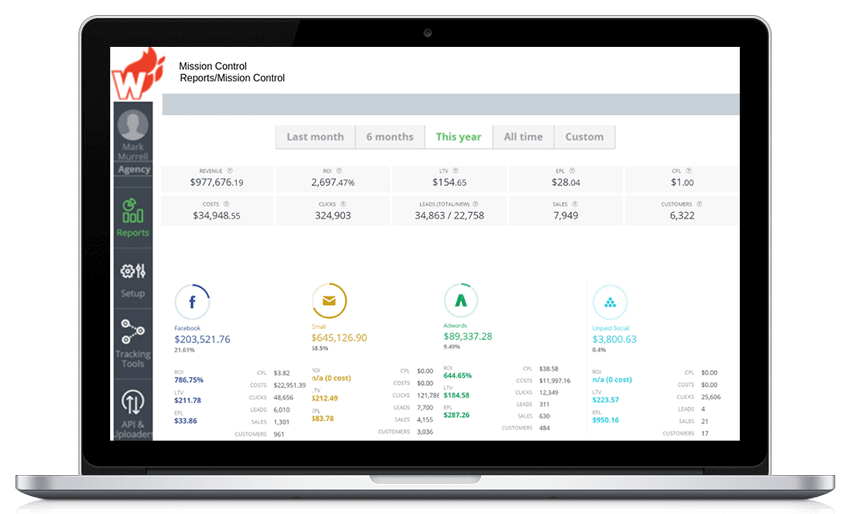
With access to real sales data, we can help you trace real revenue back to different ad campaigns, not just leads or sales opportunities.
Our “Full Impact” attribution model combines data from first-click, last-click, first opt-in, and re-optin attribution models.
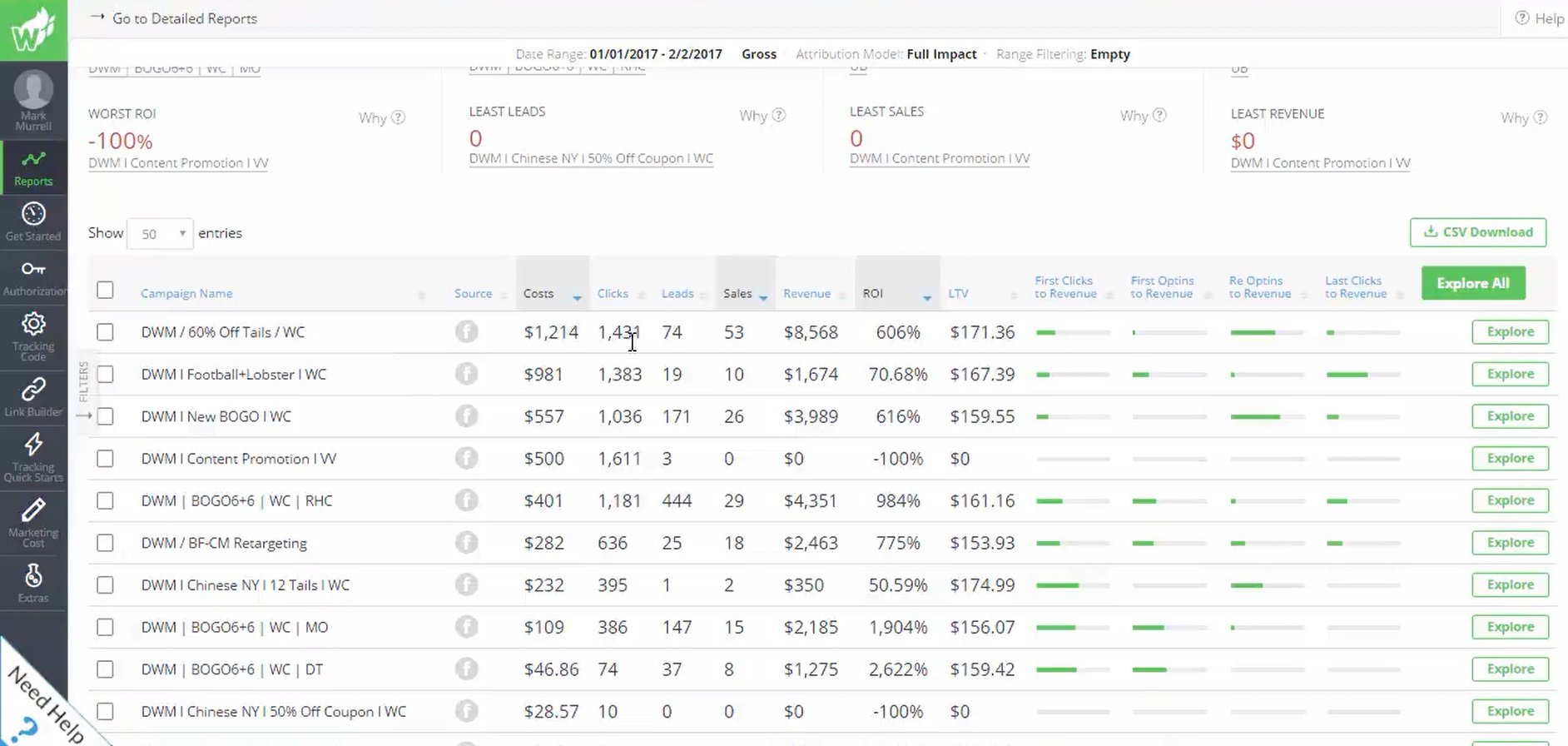
In the report, it even highlights the percentage of each type of action each campaign contributed to.
It also calculates the ROI of each campaign based on the advertising costs and the total sales it generates over time.
You can even see how each campaign impacts the LTV of your customers and the true value each campaign drives for your company beyond the initial sale.
What is attribution reporting?
Attribution reporting is a type of analytics breakdown where you identify how different campaigns contribute to conversions over time.
With Google Ads, you can access basic attribution reports that can help you identify different steps in the customer journey.
For example, with the “Top paths” report, you can see which Google Ads campaigns customers typically interact with before finally converting.

For e-commerce stores that sell consumer products at lower price points, the most typical path will probably be a single campaign or just two campaigns.
But for B2B and service companies, this report breakdown will show the different paths that your prospects take on Google Ads before finally making a purchase.
To get more modular insights, you should also view the same report with ad groups and keywords set as the primary dimension.
Another benefit of different attribution reports is that they can help you compare the conversions/ROAS across campaigns based on different attribution models.
With the attribution reporting tool within the Google Ads dashboard, you can compare their default last-click model with first-click, linear, time decay, and position-based (U-shaped) attribution models.
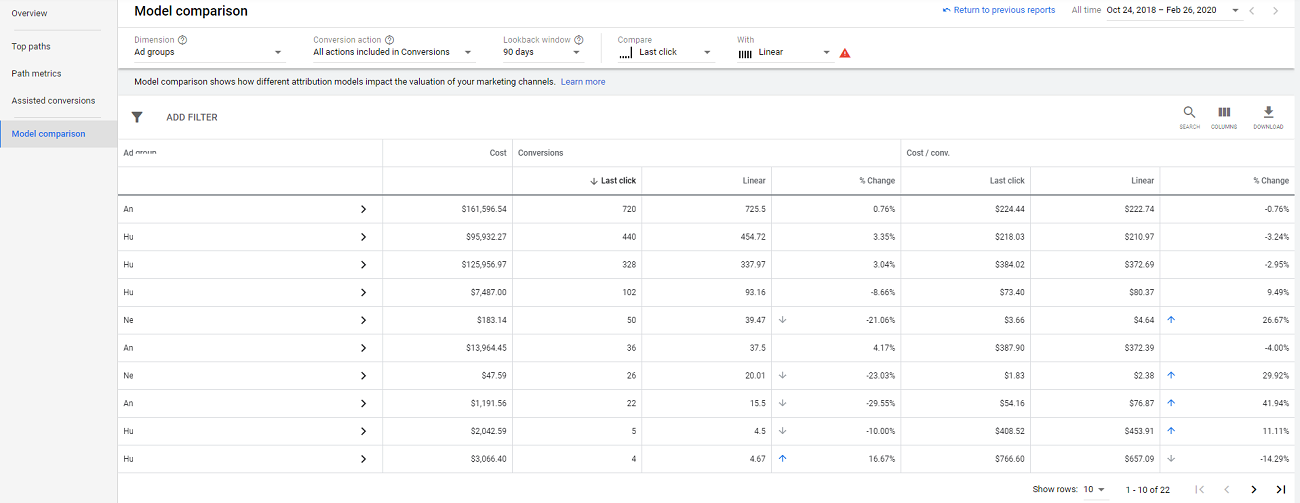
You can compare the average conversion cost, the total number of conversions, and the overall conversion value(revenue) in this report.
While these platform-specific reports are great for getting a little bit more insight into how your customers become customers, they have an obvious flaw.
Google Ads reports only evaluate the effects of your Google Ads campaigns in a vacuum. The last click on a Google ad before a conversion event may not have been the touchpoint that motivated the customer to take action.
They could have seen a Facebook or Instagram ad that finally convinced them to make the purchase.
And this comes down to how the platforms ask you to set up your conversion tracking.
The problem with basic conversion tracking
The simplest way to measure results and implement attribution models is to implement conversion tracking on individual platforms.
With Facebook Ads, you can use the integrated conversions with JS events, or create custom conversions based on website traffic to specific URLs, like a thank-you page.
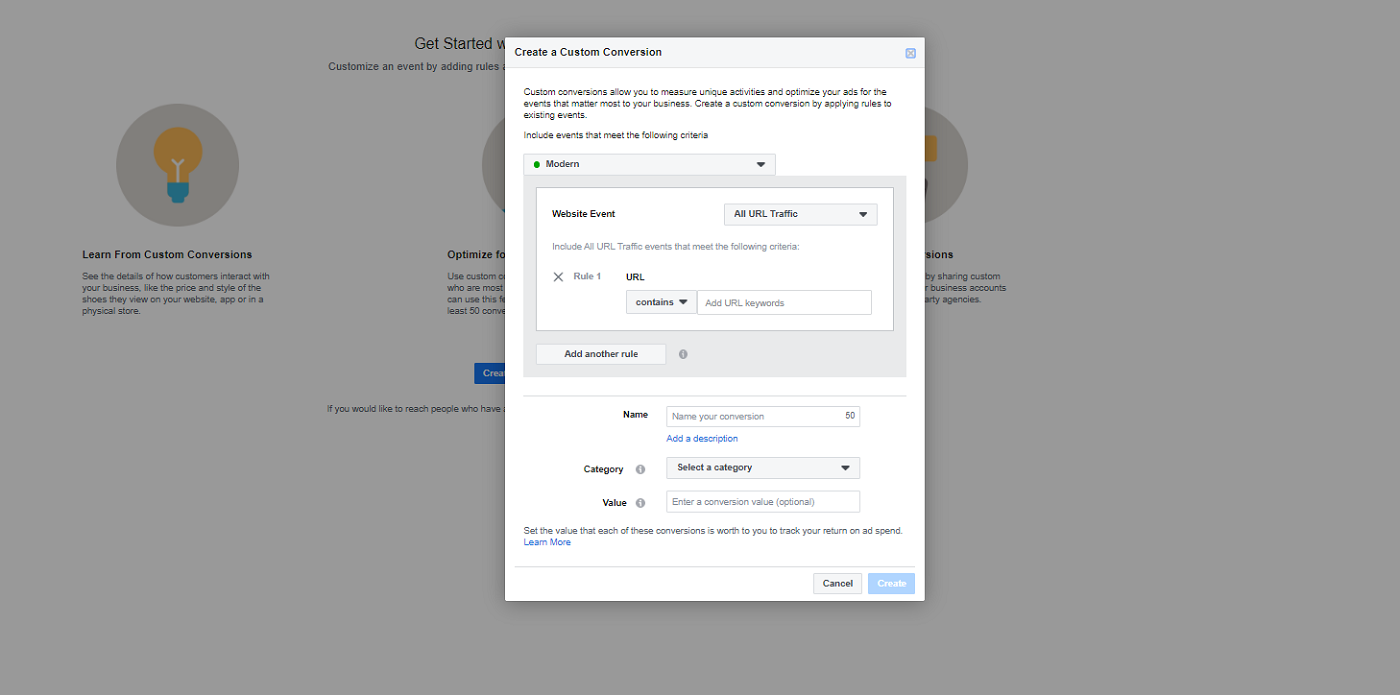
Google Ads conversions are also easy to set up, either through using the tag manager or installing code snippets directly into your thank-you pages.
But they use entirely different tracking codes, and, by default, separate scripts don’t communicate with each other at all, and neither do the platforms on an API-level either.
So the problem here is that the conversion tracking will only show you a single-channel attribution overview, with no data from other marketing platforms or organic traffic.
So if you look at the customer journey through a multi-touch attribution model on Facebook, you’ll get false information.
For example, it will identify the first Facebook ad the customer interacted with as the first touch, even when it isn’t.
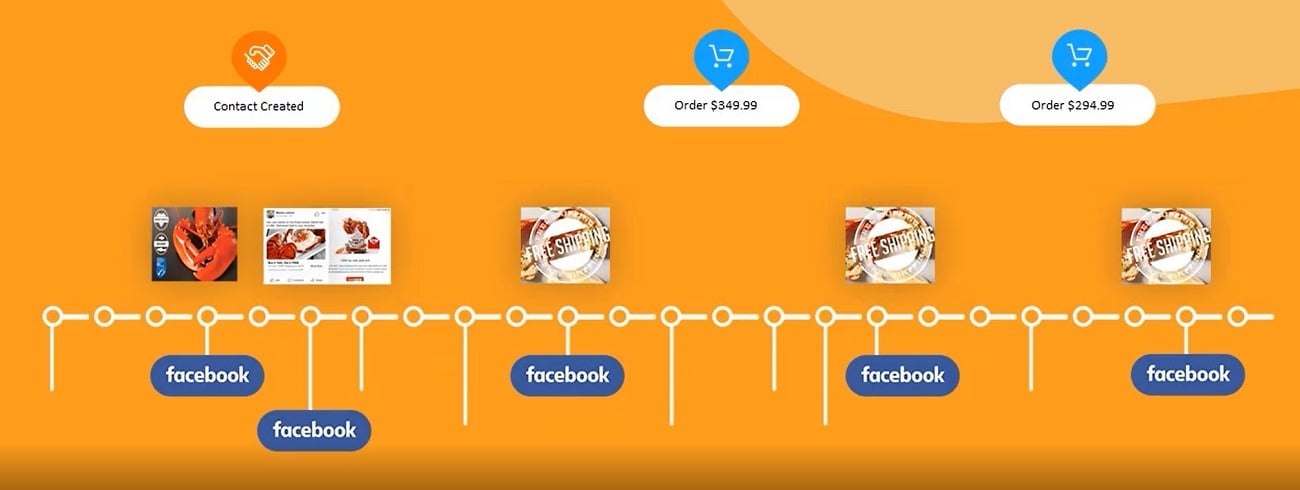
It will also mistakenly attribute different conversion events (like purchases or subscriptions) to the last Facebook ad the customer saw before completing the action.
With a multi-channel view, you can see where the customer journey starts, and which campaign is directly responsible for driving each action.
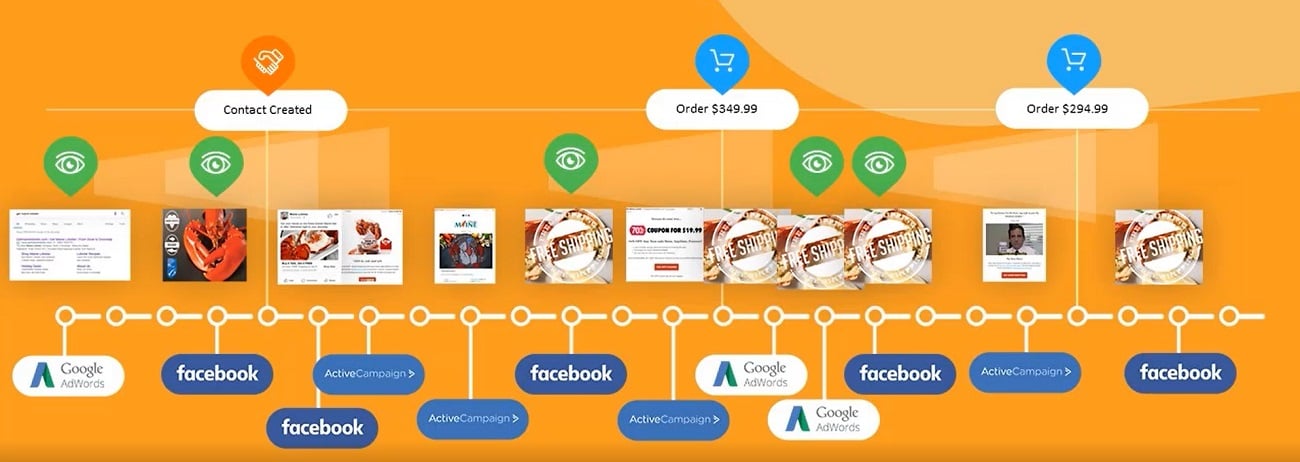
Instead of guessing what’s working, you can identify exactly which campaigns lead to which important milestone in the customer journey.
The problem with pixel-based conversion tracking is that a multi-channel customer journey is the new norm.
If you want to implement multi-channel attribution, you need to use a separate attribution tool that integrates multiple platforms and generates reports based on centralized data.
What are attribution tools?
Attribution tools are tools that help centralize data and identify and value touchpoints across multiple channels using smarter models.
Instead of just looking at a single platform, they will collect data from ad platforms, email marketing tools, CRM, and your website/e-commerce platform.
They combine web analytics with third-party sources and help track the customer journey throughout each stage.
Traditionally, marketing attribution tools have been very complicated, making them hard to set up and use. As a result, only 9.1% of marketers believed their company had an excellent understanding of attribution in 2018.
But that’s different with Wicked Reports.
Our tool has native integrations with Facebook Ads, Google Ads, your website, e-commerce platform (Shopify, WooCommerce), and CRM, so you don’t need to custom-develop solutions.
Through combining and analyzing data from different data sources, we can pinpoint precisely which ad/interaction pushed each prospect/customer to the next stage in the customer lifecycle.
And we have a collection of unique, premade, cross-channel reports that will show you what you need to know about your customers.
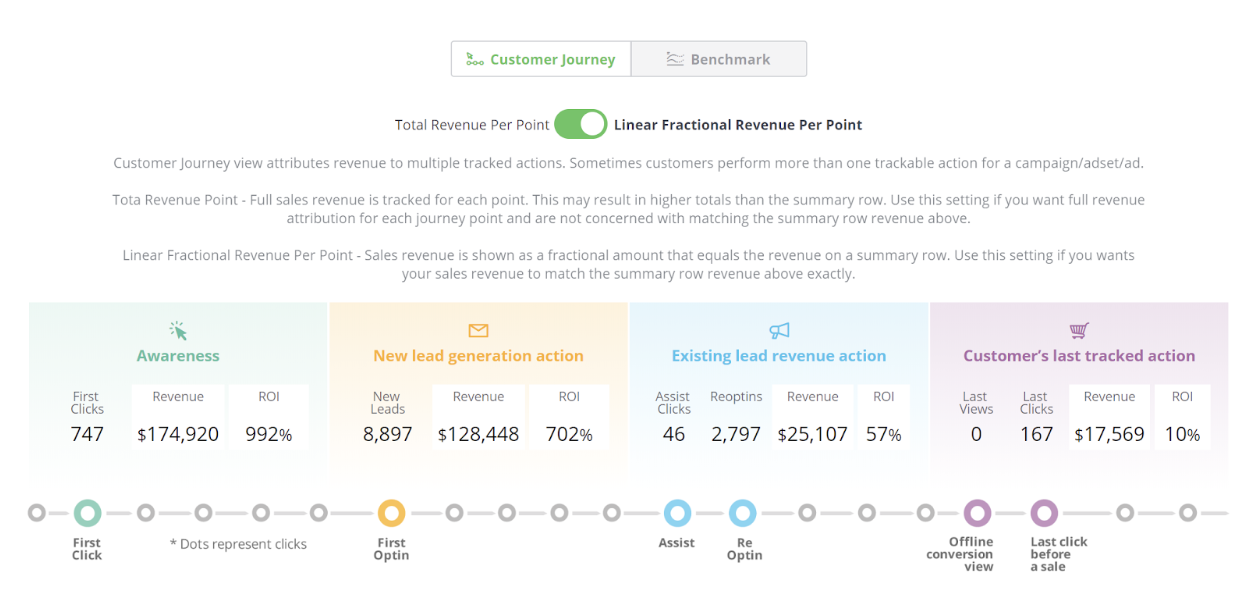
The customer journey reports show how each segment of your campaigns (awareness, new leads, existing lead campaigns) contribute to your overall revenue.
If you want more info about our attribution process, you can watch our dedicated video for more in-depth information on how we attribute sales and leads.
Final Thoughts
Marketing attribution can seem complicated to beginners with all its different models, marketing channels, and touchpoints.
But with the right tools it doesn’t have to be that way.
There’s no need to work with dated tools and basic single-channel conversion tracking and single-touchpoint models.
If you want a holistic image of your customer journeys, reliable customer lifetime value reports, and data-based insights to take your marketing to the next level, we can help.
Wicked Reports turns marketing attribution from a challenge and a timesuck into one of the biggest tools in your marketing toolbox.
With centralized data from multiple sources, we create actionable reports on LTV, audience, sales stage, missed opportunities, and more.
If you want to truly get to know your marketing performance through data as well as improve performance across the board, ask for a demo of Wicked Reports today.


